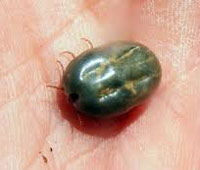
Today, the disease and its vector, referred to as the cattle fever tick, are not well known to most Americans who reside outside of South Texas, even those who raise cattle for a living. That is because the tick was largely eradicated from the United States by 1943, preventing the spread of the deadly disease. A cooperative effort between ranchers, state and federal authorities pushed the tick back to Mexico and established a buffer that became the permanent quarantine zone. Ever since, ranchers in that quarantine area have been required to abide by strict treatment requirements prescribed by state and federal regulators.
In recent years the tick has spread, and outbreaks outside of the permanent quarantine zone have occurred with increasing frequency. In fact, 2,969 premises encompassing nearly 1.4 million acres are under some level of quarantine due to the ticks. Ranchers in quarantine areas are required to meet the treatment requirements prescribed by USDA and the Texas Animal Health Commission, which in some cases can be overly burdensome and difficult to achieve. Cattle fever ticks are making a resurgence and once again threatening the cattle industry.
While cattle are closely monitored to prevent spreading the tick, growing wildlife populations can also inadvertently spread the tick as they travel in search of food and water. This is particularly true in the Laguna Atascosa and Lower Rio Grande Valley National Wildlife Refuges where the tick population has grown, largely unchecked. The U.S. Fish and Wildlife Service (FWS) oversees the refuges and has begun taking steps to better control the tick on federal lands.
In continuing their efforts, FWS requested comment on an environmental assessment that outlined eradication strategies on the two refuges. TSCRA, other organizations and many individual ranchers have responded by strongly supporting the continuation of existing eradication strategies and swift implementation of proposed eradication strategies that are outlined in the environmental assessment.
Cattle, nilgai and white-tailed deer are the most common cattle fever tick hosts present in South Texas. In their comments, TSCRA asserts that all of these potential hosts must be addressed for eradication efforts to be successful, and stressed the importance of implementing additional cattle fever tick eradication strategies due to their negligible adverse impact on the environment and the many advantages realized by eradicating cattle fever ticks from Laguna Atascosa and Lower Rio Grande Valley National Wildlife Refuges.
Currently, FWS is utilizing controlled burning and is responsibly reducing certain wildlife populations to help mitigate the tick resurgence. While this has been beneficial, additional strategies are required to effectively control the tick on the two refuges. In recognition of this, the environmental assessment proposes the use of ivermectin-treated corn for white-tailed deer treatment. A previous study conducted by USDA found negligible effects on the environment, and the medicated corn will kill ticks on white-tailed deer, one of the three major hosts for the tick. The treatment will not only improve the health of the deer population, but will prevent the deer from spreading ticks to adjacent properties.
The assessment also proposes allowing cattle grazing on the refuge. While it may seem counter intuitive, it is effective because cattle are preferred by the tick and unlike wildlife the cattle can be rounded up and treated year-round. Cattle still graze many of the over 550 refuges in the National Wildlife Refuge System, and cattle grazing occurred on the Laguna Atascosa National Wildlife Refuge from its founding in 1946 until 1974. On the Lower Rio Grande Valley National Wildlife Refuge, a 2002 study found that grazing would have a mutual benefit to the refuge by reducing invasive grasses that threaten native habitats. Cattle would not only be a mechanism to eradicate cattle fever ticks, but would also reduce the risk of wildfires and assist the establishment and recovery of native brushland vegetation.
“We greatly appreciate the actions taken by FWS thus far to eradicate the cattle fever tick on federal lands, including the utilization of prescribed burning and the responsible reduction of both native and invasive wildlife host population,” said Richard Thorpe, a rancher and current president of TSCRA. “Their commitment to furthering eradication efforts by implementing these new strategies will benefit affected wildlife, surrounding communities and the entire beef industry.”
The comments submitted by TSCRA, and the FWS environmental assessment are available online.